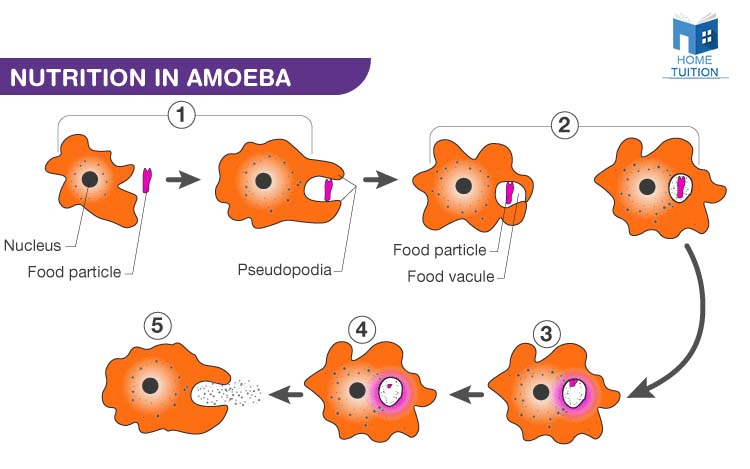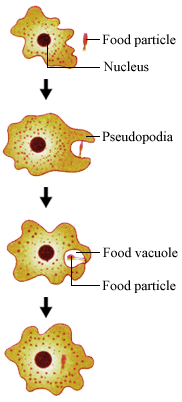Nutrition in Amoeba happens via phagocytosis, where the organism engulfs its food. This process, known as holozoic nutrition, includes ingestion, digestion, and egestion of food. Amoeba lacks specialized organs for nutrition. Instead, it relies on pseudopodia along its body surface for the entire process.
Nutrition In Amoeba Definition
It is the process by which this single-celled organism obtains and consumes food. Amoeba feeds on microscopic organisms and organic matter by engulfing them through pseudopodia, a process known as phagocytosis. Once the food is engulfed, it is enclosed in a food vacuole where digestion occurs. Nutrients are then absorbed, and waste materials are expelled through the cell membrane.
Also Read: Nutrition in Amoeba
Nutrition In Amoeba Diagram

What is Holozoic Nutrition?
Holozoic nutrition occurs in organisms that ingest solid or liquid food into their bodies. Amoeba is an example of an organism that exhibits holozoic nutrition.
Holozoic nutrition in amoeba takes place in the following steps given below:
- Ingestion
- Digestion
- Absorption
- Assimilation
- Egestion
Also Read: Nutrition In Plants
Process Of Nutrition In Amoeba
Ingestion
Since it is unicellular so a single cell is responsible for carrying out all the vital activities. Food is ingested with the help of pseudopodia. Animal engulfs the food particle lying near it by forming pseudopodia around it and forming a food vacuole which is considered as its temporary stomach.
Digestion
The enzymes from surrounding cytoplasm enter the food vacuole and break down the food into smaller and soluble forms. It is interacellular in Amoeba.
Absorption
The digested food is now absorbed by cytoplasm by simple diffusion.
Assimilation
The food absorbed in amoeba is used to obtain energy from respiration, for its growth and reproduction.
Egestion
Undigested food is thrown out of the cell.

Frequently Asked Questions
Ans. Amoebae are highly efficient at killing bacteria (33). They locate bacteria through chemotaxis and eliminate them through phagocytosis, a process where cells engulf and ingest other cells or particles. Amoebae can engulf and eliminate most bacteria.
Ans. Amoeba obtains its nutrition through a process known as phagocytosis, wherein the organism engulfs the food it intends to consume.
Ans. The food ingested is engulfed by pseudopodia through the process of phagocytosis.
Ans. The five steps of nutrition that include ingestion, absorption, digestion, assimilation, and egestion.
Ans. Amoebas move by using bulging parts called pseudopodia.